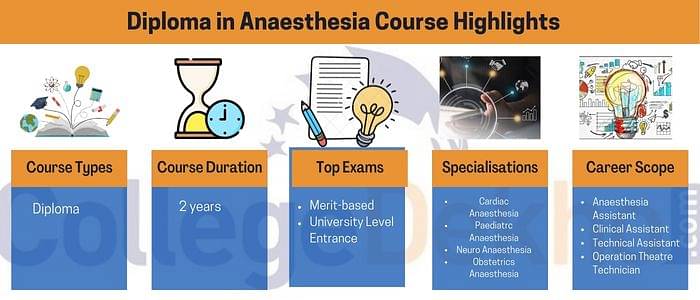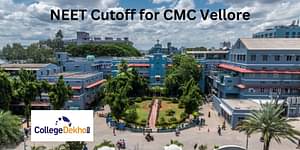Diploma in Anaesthesia
About Diploma in Anaesthesia
Diploma in Anaesthesia is a 2 year postgraduate degree that is pursued by candidates after they have completed their higher secondary education. The minimum aggregate required for admission to Diploma in Anaesthesia is 50%. The curriculum of the programme has been designed to offer training and understanding of anaesthesia and administer dosages of the same to patients according to the severity and type of illness or procedure. The syllabus of the Diploma in Anaesthesia includes subjects like Biochemistry, Human Physiology, Anaesthetic Procedures, and Chronic Pain Therapy.
There is no specific entrance test for this degree course. Admission to Diploma in Anaesthesia is done on merit basis. The average course fee for Diploma in Anaesthesia is between INR 56,000 to INR 1,00,000 INR. The entire coursework is conducted in regular mode. Some of the best colleges in India that offer this diploma degree are LLRM Medical College, Lokmanya Tilak Municipal Medical College, B.J. Medical College, and Maharajah’s Institute of Medical Science. After completing a Diploma in Anaesthesia, graduates can seek work as Anaesthesia Assistants, Clinical Assistants, and Technical assistants. The average salary of professional graduates of Diploma in Anaesthesia ranges from INR 1,50,000 to INR 3,00,000 per annum.
Table of Contents
- About Diploma in Anaesthesia
- Diploma in Anaesthesia Course Highlights
- Diploma in Anaesthesia Eligibility Criteria
- Diploma in Anaesthesia Admission Process
- Diploma in Anaesthesia Course Fee
- Diploma in Anaesthesia Syllabus
- Difference between Diploma in Anaesthesia and B.Sc Anesthesia
- Diploma in Anaesthesia Career Options and Job Prospects
- Skills Required for Diploma in Anaesthesia
- Best Books for Diploma in Anaesthesia
- Diploma in Anaesthesia Salary
- Colleges in India Offering Diploma in Anaesthesia (State and City Wise)
- Foreign Colleges Offering Diploma in Anaesthesia
- Popular Colleges in India Offering Diplomas in Anaesthesiology
- Why Choose Diploma in Anaesthesia?
- FAQs about DA
Diploma in Anaesthesia Course Highlights

Here are some of the course highlights of the Diploma in Anaesthesia:
| Name of Course | Diploma in Anaesthesia |
|---|---|
| Level | UG |
| Duration of Course | 2 Years |
| Course Mode | Full-Time |
| Exam Type | Semester |
| Minimum Academic Requirement | 10+2 in Science |
| Minimum Aggregate Score Requirement | 45% or More |
| Subject Preference | Physics, Chemistry, and Biology or Mathematics |
| Admissions / Selection Process | University-Level Entrance / Merit-Based |
| Average Course Fee | INR 56,000 - INR 4,00,000 |
| Average Initial Salary | INR 1,50,000 - INR 3,00,000 |
| Areas of Employment | Govt/Pvt Hospitals, Dental Clinics, Healthcare Centres, etc. |
Diploma in Anaesthesia Eligibility Criteria
- Candidates must have cleared their class 12 board exams in the stream of science from a recognised board of education such as CBSE, ICSE or State Board.
- They must have secured a minimum aggregate score of 45% or more in subjects such as Physics, Chemistry and Biology or Mathematics at the qualifying examination.
- Entrance Tests may be conducted at the University-level, therefore, candidates must have a valid University-level entrance test score/rank.
Diploma in Anaesthesia Admission Process
In order to pursue a 2-year Diploma programme in Anaesthesia, all aspirants will be required to go through a defined admission process for Diploma in Anaesthesia course. While each college or institution offering the course will define their own admission process and guidelines, there are general guidelines that each aspirant must follow. There are two prominent admission Diploma in Anaesthesia admission processes followed in India, viz. University-level entrance-based and merit-based admission processes. Here are the admission processes and guidelines for Diploma in Anaesthesia.
Entrance-Based Admissions
Under entrance-based admissions, for Diploma in Anaesthesia, the candidates may be asked to attempt a University-level entrance test on the stipulated date and time.
After attempting the entrance test, the respective university or college will release an appropriate merit list containing the name, score and/or rank of the candidate.
Based on these ranks and/or scores, the candidates will be called to participate in further selection processes, which may include a Personal Interview and/or Group Discussion.
The overall performance of the candidate in the entrance test and the personal interview and/or group discussion, candidates will be shortlisted for admission.
Merit-Based Admissions
Candidates will be asked to appear for the selection processes as has been defined by the respective colleges for offering admission to Diploma in Anaesthesia on merit-basis.
These selection processes may include a Personal Interview and/or Group Discussion, as per the discretion of the college.
Depending on the overall performance of the candidates in the selection parameters such as the past academic record and the performance in the personal interview and/or group discussion, the university/college will offer admissions to the prospective students in the course.
Counselling-Based Admission
Another uncommon yet viable admission process is the counselling-based admission processes, which are usually common among universities with many constituent or affiliated colleges/institutions. This method of admission can be found in both entrance test and merit-based admission processes.
Under entrance-based admission process, the universities will release a merit list containing the names of each applicant, in the order of merit which will be calculated using the scores obtained in the entrance test.
Under merit-based admission, merit lists will contain the names of the candidates in the order of their merit, which will be calculated based on the information provided by them in the application form and documents that have been furnished.
Depending on the rank/score of the candidate in the merit list, the university will call the student to take part in the counselling processes, which requires them to select the course and college of their choice.
On the basis of their choice of college and course, their rank/score and the availability of the seats in the course, the candidate will be offered seats.
Note: It should be noted that the admission processes that have been mentioned above are general and are subject to change based on the requirements of individual colleges. Therefore, candidates are advised to check out the admission processes and eligibility criteria for the respective courses.
Diploma in Anaesthesia Course Fee
If you wish to pursue the 2-year diploma programme, you will be charged an annual course fee for Diploma in Anaesthesia ranging anywhere between 56,000 to 4,00,000 INR. The average Diploma in Anaesthesia course fee will depend on various factors such as the ownership of the institution, the popularity of the course, and much more. Government colleges offering Diploma in Anaesthesia courses are comparatively cheaper than that offered by private colleges. The course structure for some of the popular colleges in India are listed below
| College/University | Course Fee |
|---|---|
| Lokmanya Tilak Municipal Medical College, Mumbai | 3,00,000 INR |
| B.J.Medical College, Ahmedabad | 20,000 INR |
| Aliragh Muslim University, Aligarh | 4,50,000 INR |
| Maulana Azad Medical College, New Delhi | 30,000 INR |
| Maharajah’s Institute of Medical Science | 60,000 INR |
Diploma in Anaesthesia Syllabus
First Year:
| Applied Human Physiology and Anatomy | Introduction to Anaesthesia: Physics |
|---|---|
| Physiology of Anaesthesia | Metabolic Response to Trauma & Stress |
| Pharmacology of Anaesthesia | Biochemistry |
| Post-Anaesthesia Care Rooms | Defensive Anaesthesia |
Second Year:
| Computers in Anaesthesia | Cardiovascular Pharmacology |
|---|---|
| Anaesthetic Techniques | Geriatric/Paediatric Anaesthesia |
| Anaesthetic Postures | Third World Anaesthesia |
| Chronic Pain Therapy | Neonatal Resuscitation |
Difference between Diploma in Anaesthesia and B.Sc Anesthesia
Here is a difference between the two most popular courses for Anesthesia.
| Parameters | Diploma in Anaesthesia | B.Sc Anesthesia |
|---|---|---|
| Admission Criteria | NEET, Merit based | Merit based, Entrance exam |
| Focus Area | Diploma in Anesthesia helps students gain knowledge and skills on implementing anesthesia methods | BSC Anesthesia offers a theoretical as well as practical understanding of all the ins and outs of the field |
| Duration | 2 Years | 3 years |
| Average Course Fees | INR 42,000 to 15,00,000 | INR 25,000- 41,000 |
| Eligibility Criteria | Clear 10+2 with a minimum of 50% and above percentage | Clear 10+2 with a 45% minimum score |
| Job Options | Radiologist, Medical consultant, Anaesthetist, Paediatrician | Anesthesia technician, Pediatrician, Medical consultant, Clinical associate |
| Average Placement Package | 3 - 11 LPA | 4 LPA |
| Areas of Employment | Hospitals in India as well as organizations in abroad | Medical hospitals and clinics |
Diploma in Anaesthesia Career Options and Job Prospects
The career scope and job options after Diploma in Anaesthesia course are immense as anaesthetic technicians are crucial components of the healthcare industry. With the number of hospitals and the overall population increase in the country, the need for skilled and qualified anaesthesia technicians will increase as well. There are several employment opportunities for graduates of the course to find a course in the field of anaesthesia, some of which include:
- Government and Private Hospitals
- Government and Private Dental Clinics
- Health Care Centres
- Medical Colleges/Universities
Under any one of the employment areas in the healthcare sector, graduates with Diploma in Anaesthesia will find a career path with numerous job profiles. Some of the job profiles for Diploma in Anaesthesia graduates in India are as follows:
- Anaesthesia Assistant
- Clinical Assistant
- Technical Assistant
- Operation Theatre Technician
- Medical Lab Technician
After finishing a Diploma in Anaesthesia, one will be able to earn an annual package ranging anywhere between 1,50,000 to 15,00,000 INR. With better experience, skills and qualifications, you will be able to earn a much higher salary.
A better and viable option after graduating with a Diploma in Anaesthesia is to pursue higher education such as a Bachelor’s degree in one of the allied health sciences. Some of the bachelor’s programmes available for Diploma in Anaesthesia graduates include:
- B.Sc Nutrition Dietetics
- B.Sc in Radio Imaging Technology
- B.Sc in Operation Theatre Technology
- B.Sc Neuro-Physiology Technology
- B.Sc Cardiac Care Technology
- B.Pharm
- B.Sc Nursing
- Bachelor of Physiotherapy
There are many more similar courses on offer for a Diploma in Anaesthesia graduate in India, in terms of higher education prospects. Pursuing higher education will highly improve your career prospects and give you a better chance of building lucrative career options.
Skills Required for Diploma in Anaesthesia
The desired skills for excelling in this field of study are listed below.
Knowing medical terminology: It is a crucial skill for professional graduates of Anaesthesia. Having a good grasp of medical terminology helps to easily work with other medical practitioners when required.
Dedication: This skill is specified not only for any particular profession but in all hemispheres of professional life. A person who is dedicated to his/her career will always achieve heights in all terminology. Dedication towards the profession will only help in bringing out the best in you and will ultimately work towards the greater good.
Patience: It is important to have patience in the medical lines, especially because in case of any medical emergencies, medical professionals need to respond with the utmost professionalism and keep patience. They need to keep a calm mind while dealing with patient parties.
Ability to work under pressure: Most of the time, anaesthesia specialists need to participate in surgical procedures. It is crucial for these professionals to work skillfully under extreme pressure conditions. The ability to respond quickly and effectively to emergency situations eventually leads to successful surgical procedures.
Thorough knowledge of the subject: A person who has the proper knowledge about their subject is bound to perform well in their profession.
Acquaintance with medical equipment: Having proper knowledge about the medical equipment that is used during the surgical procedure, is crucial. A person who is well-acquainted with medical equipment will be able to respond to quick calls in case of emergencies and surgical procedures.
Problem Solving Skill: This skill is important to respond to the different needs of the patients. During any medical emergency, the requirements of the patients differ. So, it is important to possess problem-solving ability in order to meet diverse medical needs and administer medical attention as required.
Best Books for Diploma in Anaesthesia
There are several books in the marker that students of Diploma in Anaesthesia refer to. Some of the best books for this course are -
| Book | Author |
|---|---|
| Miller’s Anaesthesia | Michael A. Gropper |
| Anaesthesiologist’s Manual of Surgical Procedures | Richard A.Jaffe |
| Cardiac Anaesthesia | Joel A. Kaplan |
| Anaesthesia and Co-Existing Diseases | Robert L. Hines |
| Anaesthesia Equipments | James M. Berry |
| Anaesthesia Review Vol. 2 | Kaushik Jothinath |
| Clinical Anaesthesia | Dr. Nishkarsh Gupta |
| Drugs in Anaesthesia | Pramodh Kumar |
| Lee’s Synopsis of Anaesthesia | Jeremy N.Cashman |
| Anaesthesiology Cases | Lange |
Diploma in Anaesthesia Salary
The average salary scale for professional graduates of Anaesthesia in India ranges from INR 1,50,000 to INR 15,00,000. The salary scale is prevalent in the initial professional years of the person. Depending on the work experience, the highest educational qualification in this subject, the expertise and competency of the person, and the achievement of the professional, the salary can be much higher.
Colleges in India Offering Diploma in Anaesthesia (State and City Wise)
The state and city-wise distribution of the popular colleges in India offering Diploma in Anaesthesia are -
Telangana
| College/University | City |
|---|---|
| SVS Medical College | Mahabubnagar |
| Kamineni Institute of Medical Sciences | Nalgonda |
Maharashtra
| College/University | City |
|---|---|
| Seth GS Medical College | Mumbai |
| Mahatma Gandhi Institute of Medical Sciences | Wardha |
| Topiwala National Medical College | Mumbai |
Uttar Pradesh
| College/University | City |
|---|---|
| Era’s Lucknow Medical College | Lucknow |
| Baba Raghav Das Medical College | Gorakhpur |
| Maharani Laxmi Bai Medical College | Jhansi |
Foreign Colleges Offering Diploma in Anaesthesia
Some of the foreign colleges that offer Diploma in Anaesthesia are -
| College/University | Location |
|---|---|
| University of St. Andrews | United Kingdom |
| University of Bristol | United Kingdom |
| Ulster University | United Kingdom |
| University of Galway | Ireland |
| The University of New South Wales | Australia |
Popular Colleges in India Offering Diplomas in Anaesthesiology
There are many popular colleges in India that offer admission to Diploma in Anaesthesia degree. A few top colleges are listed below.
- Singhania University
- Rajasthan University of Health Sciences
- Kovai Medical Center and Hospital
- Netaji Subhash Chandra Bose Medical College and Hospital
- Sri Sathya Sai Institute of Higher Medical Sciences
Why Choose Diploma in Anaesthesia?
There are several reasons for choosing to complete a diploma in anaesthesia. Some of them are given below.
- The main job area of professional graduates of Anaesthesia is very intellectually challenging and exciting. This field of work is very practical and important. The job role of anaesthesiologists is important in every medical establishment. They are required in case of any medical emergencies and surgeries.
- There are a lot of opportunities in this field. People studying an anaesthesiology degree are capable of starting their career much earlier than other medical practitioners.
- The work-life balance is perfect in the case of professional graduates of anaesthesia. Unlike other medical professionals, who have to regularly attend emergency room calls in hospitals and nursing homes, anaesthesiologists get proper work off time.
- For professionals who want to help and serve people using their medical knowledge, a degree in anaesthesia is the best choice. These professionals are entrusted with the responsibility to reduce the pain experience in patients by administering anaesthesia. They have the ability to nullify the pain and other problems of people undergoing major or minor surgeries.
- A professional graduate of anaesthesia is eligible for employment in both private and government sectors of the country. They are essential personnel in every hospital and hence there is a constant demand for anaesthesiologists.
FAQs about DA
s there any specific entrance exam for a Diploma in Anaesthesia?
No, there is no specific entrance exam for taking admission to Diploma in Anaesthesia degree. However, each college/university arranges its own entrance test.
What is the average course fee for a Diploma in Anaesthesia?
The average course fee for Diploma in Anaesthesia in India lies within the range of 56,000 to 1,00,000 INR.
What is the maximum duration of a Diploma in Anaesthesia?
The maximum duration for completing a Diploma in Anaesthesia degree is 2 years. Aspirants will be able to study all the topics related to the coursework during this period.
What are some recruiting agencies for Diploma in Anaesthesia graduates?
There are many government and private establishments that hire professional graduates with Diploma in Anaesthesia degree. Some of the top names are
- Apollo Hospitals
- Tata Memorial Center
- Max Hospitals
What are some job profiles after completing a Diploma in Anaesthesia?
Some of the top designations with high salaries after completing a Diploma in Anaesthesia are
- Clinic Associate
- Surgeon
- Technical Assistant
. What is the scope after a Diploma in Anaesthesia?
There are ample opportunities after completing a Diploma in Anaesthesia. Besides finding lucrative job positions, those who want to complete higher studies can pursue other specializations or an MBBS degree.
Can I become an anaesthesiologist without an MBBS degree?
It is not possible to become an anaesthesiologist without an MBBS degree. After completing an MBBS, students can choose to complete a specialization or MD in Anaesthesia.
What are some government medical colleges for Diploma in Anaesthesia?
There are many government medical colleges that offer Diplomas in Anaesthesia degrees. Some of them are -
- All India Institute of Medical Sciences
- Armed Forces Medical College
- Aligarh Muslim University
Is Anaesthesiology hard to study?
The toughness of any course totally depends on the student. Besides, any medical degree is hard to achieve. One has to go through a rigorous process in order to complete the degree.
What are some job profiles after a Diploma in Anaesthesia?
Some of the job designations after completion of the Diploma in Anaesthesia are
- Anaesthesia Assistant
- Clinical Assistant
- Technical Assistant
Related Questions
Popular Courses
- Courses
- Diploma in Anaesthesia


















